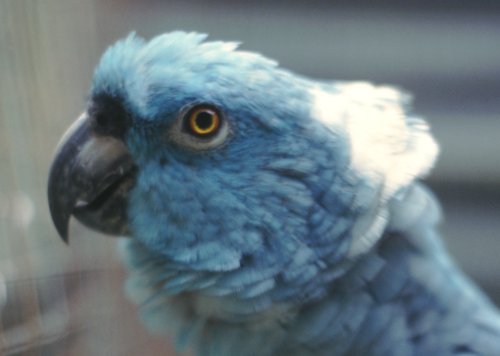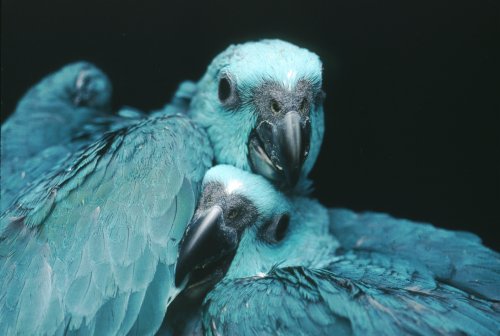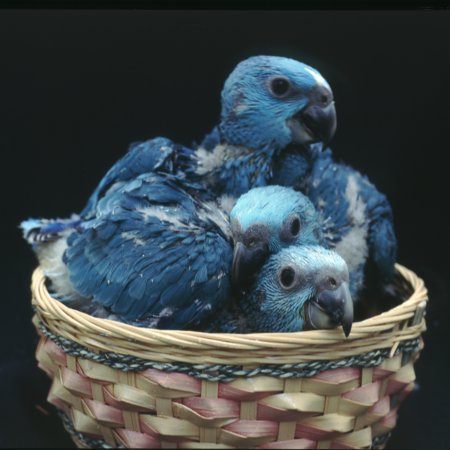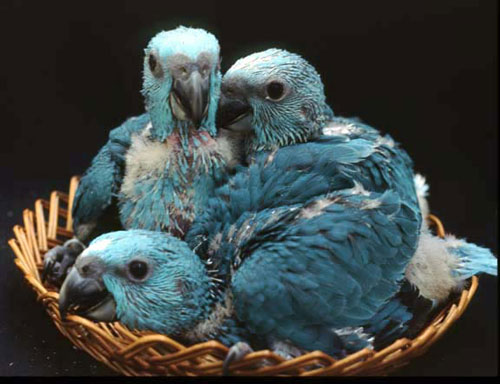Blue Mutation Yellow-Naped Amazon
© Howard Voren. Click here to use this content.The Blue Mutation Yellow-Naped Amazon, (Amazona ochrocephala auropalliata), is one of most sought after parrots in the world. These Blue Amazons are more intelligent than most of their green relatives and their gorgeous blue color and larger size give them an impressive presence that cannot be captured in a photo.
Serious inquiries by anyone wishing to purchase a beautiful blue mutation Amazon can be sent to [email protected].

A mature male blue Amazon begins to raise his sparkling white nape feathers as a territorial display.
HISTORY
At one point during the importation era, the search for the “mythical” Blue Amazon reached nearly epic proportions. Two wild pairs were found that produced this color mutation, but, although each pair occupied their same nests each season, a clutch with a blue baby might come only once in many years.
Voren’s vocation put him in Honduras at just the right time to acquire two young Blue Mutation Amazons from the separate wild nests in two consecutive years. In another stroke of luck they turned out to be a male and a female! At that time they were the only pair of Blue Mutation Amazons in the world. After years of expeditions, this pair was two of the only four specimens that existed in aviculture. The other two were long-term captive males that were proving difficult to pair with normally colored hens.
The years of anticipation became fruitful when Voren’s Blue Mutation Yellow-Naped Amazons became the first pair in the world to produce Blue Amazons in captivity. His project would allow him to place pairs of these fabulous birds in some of the worlds top breeding facilities. Three other reputable professional facilities have now successfully produced blue offspring from the blue bloodlines supplied by Voren’s efforts.
Several years after the original pair began producing; Voren received a call from one of the Honduran bird brokers he had worked with in the past. A pair of young blue mutation birds were available for sale, but both were harvested from the same nest as Voren’s blue male, and therefore siblings. In addition, since Honduras no longer exported birds, they would have to be transported to Nicaragua to be exported to the U.S.A. Voren refused the offer.
The pair later fell into the hands of an American who was importing reptiles from Nicaragua. They were again offered for sale and Voren again refused. The birds were eventually acquired by a California aviary where they were bred together, and the inbred offspring are being sold to the public at bird shows and conventions where they can be exposed to a variety of contagions.
These naturally occurring color morphs are precious gems. The buyer should be aware of both the provenance and potential health issues before making such an investment with a cut rate vendor at a fair, rather than with a well-established professional captive breeding facility.
FREQUENTLY ASKED QUESTIONS
COLOR
They are all blue where they would normally be green and they are white where they would normally be yellow or red. When two of these Blue Amazons are bred together, all of the offspring are always blue.
HOW DOES THIS HAPPEN?
A simplistic explanation as to how this comes about would be to consider that green Amazons are not actually green. They are a mixture of blue and yellow which causes our eyes to visualize the color green. When something happens genetically that eliminates the cause of the color yellow in the feathers, then the only color that remains is blue. If something happens genetically that eliminates the cause of the color blue in the feathers then the only color that remains is yellow. If something happens genetically that eliminates the cause of both the color yellow and blue then these normally green Amazons would be white.
Yellow Naped Amazons, as they mature, will naturally lose the ability to produce blue in the area of the nape. This is what causes that area to “turn” yellow in normally colored birds. In actuality they are not really “turning” yellow but losing blue which allows us to visualize the remaining yellow. In Blue Yellow Napes, this area will become white as their genetic tendency to lose the blue coloration in the area, combines with their genetic lack of yellow.
SIZE & PERSONALITY
They are more intelligent and larger than most Yellow-Napes and that has been the opinion of all that have worked with them. Their talking ability and desire to engage in speech is incredible and they will talk whether you choose to formally teach them or not. This is also true of those that are kept as future breeders and therefore not kept tame or interacted with as family or personal pets.
Over the years, Voren’s Aviaries has had many tame and talking Yellow-Naped, Double-Yellow Headed and Blue-Fronted Amazons that have come out of long term pet homes and have been set up for breeding with an acceptable mate. After a few years of being surrounded by other mature breeding Amazons, they almost never utter a word in “human speak” and pick up normal Amazon sounds and calls from all the wild caught Amazons around them. These natural calls have been “handed down” from generation to generation on Voren’s farm. At present, even though the vast majority of Amazons on the farm are now either second or third generation captive bred, the “calls of the wild” continue. Even his 40 year old double-yellow head, that was his personal pet and prolific talker for the first 20 of his years, completely converted to natural calls and no longer utters a sound that is similar to human speech.
Only the Blue Yellow Napes show a major diversion from this natural tendency. They not only continue to engage in “human speak” but those that have never learned anything from a human will pick it up from other blues within hearing distance. They are almost a “race” unto themselves.





